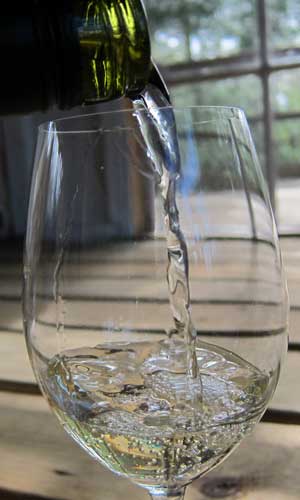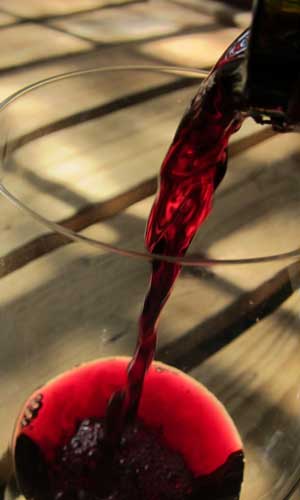We’re supposed to refer to it as “value priced”—the cheap wine. Not a lot of money. Under $15 and most likely, under $12.
Often, this translates to metallic, thin, ambiguously sweet and unambiguously disappointing. Sip after sip, you reacquaint yourself with this unfortunately familiar mélange of flavors and aromas. It’s wine, it’s drinkable, but it’s oh, so tragic.
Yellow Tail, Beringer, Gallo, Two Buck Chuck—there are certain labels that embrace and thrive in the cheap. Needing to bring wine to a party full of people who don’t really care? Apathetic? Desperate? These are the wines you buy. I’ve been to some of the swankiest country clubs around and chuckled to myself as I noticed they were pouring crap that, at cost, is around $4 a bottle. They get away with this because these types of wine aren’t available retail. Distracted by the glamour of being in a country club or fancy restaurant, what’s poured in the glass seems to always taste real, real good.
A similar spellbound uplift ensorcelled me when it comes to French wines. I’ve put them on a pedestal. I have. I do this with Italian wines as well, but there’s something about France with it’s terroir, it’s classification system, its history. It wasn’t until The Judgment of Paris in 1976 that the US was even considered a bona fide quality wine producer.
So when I heard about the wine lake, I was shocked. There was even a little schadenfreude seeping in as I thought, “Ah ha! Those French bastards! Serves them right with those French labels and silent letters and three-hour lunches and their cheeses and their kisses….”
The wine lake is not a real “lake” per se but a euphemism to describe something that’s not at all mildy amusing or funny. Millions of gallons of wine, bought back by the French government, are turned into rubbing alcohol every year. Enough to fill a lake, as it were. Bloomberg explains that in addition to the labels, unruly, independent grape growers who are reluctant to not only change with the times but work together as well as a glut of admittedly lackluster wines are to blame. And with France being the world’s largest producer of wine, well, this phenomenal situation exists. Until last year when, after years of pulling vines, vintners going under and a terrible, terrible growing season (read “The Wine Lake Is Decisively Drained” for more on this), the market for French wine might be improving.
Having said all this, the French wine section sparkles with treasure. Just because there is less supply doesn’t mean that demand will be increasing anytime soon. Here are two value-priced selections. Cheap, really. And oh, so lovely.
 2011 La Levraudiere Muscadet, Sévre & Maine ($11.99)
2011 La Levraudiere Muscadet, Sévre & Maine ($11.99)
Immediately apparent is that this is a full-bodied wine. Think cough syrup versus water; this is closer to the cough syrup. We all know that full-bodied whites exist. We’ve all had a full-bodied white. But I’ve had so many lithe, thirst-quenching whites that I’m still taken aback when I drink one that not only tastes a little creamy but actually feels creamy. And I love light-bodied whites. A hot day in the summer? Yes, please. A cold day in the winter? That, too.
The name of the grape (or varietal) is Muscadet (mus-kuh-DAY). The other two words – Sévre and Maine – are in reference to the sub-appelation or vineyard location.
Typical of this grape, as with many white grapes: melon, white floral and citrus. I always feel like a schmuck when I say things like orange blossoms because I’ve never smelled an orange blossom. But here I go. I smell something like a very mild orange and a very mild floral. In something that feels more akin to addition than extrapolation, orange blossom makes sense to me. Just as silly is to point out the minerals and funk. But we’ve all stepped outside just as it starts to rain. We can smell something released in the air that’s earthy and…minerally. I get this when I smell and taste this wine. And then, all of this is creamy. And so, if you’re a fan of Chardonnay, you will also love Muscadet.
 2011 Charles Brotte Grand Vallon Syrah ($8.99)
2011 Charles Brotte Grand Vallon Syrah ($8.99)
I love The Washington Post and love it even more when I found that they gave a shout out to this beauty. What’s important to know is that it’s Syrah. Grown in Australia, for instance, this is called Shiraz. But grown in France, it’s Syrah. It’s also much more brooding and tastes less like dessert in a glass and more like something meant to accompany your meal.
Nose: It’s not often I encounter a plume of lavender, herbs and dark berries. Just as evident is a funk, something I much prefer over sugary sweet.
Mouth: As they say, the nose is realized on the palate. I’m not good enough to distinguish just what type of dark berries make up the fruit portion, but they’re there. Keeping things from getting out of control are shimmers of dry cocoa, dried herbs (I swear, I could taste oregano) and more of that funk, albeit subtle. This wine has also seen some oak. Nothing gratuitous, thank the gods.
These are not obscure wines, but call around before you go out on a wine run.
Le Cheers!